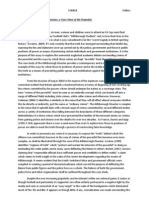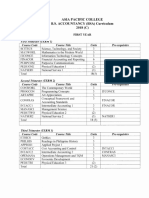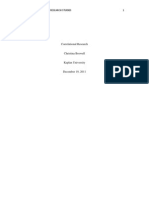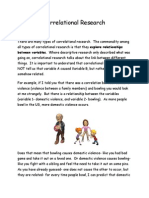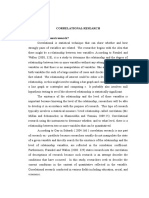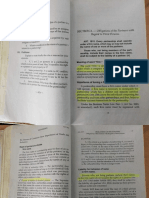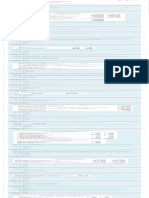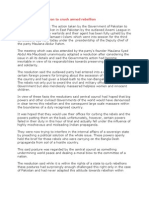0 ratings0% found this document useful (0 votes)
340 viewsCorrelational Research - Definition With Examples - QuestionPro
Correlational research involves measuring the statistical relationship between two variables without influencing either variable. It establishes whether changes in one variable correspond with changes in the other. There are three types of correlations: positive (changes in variables occur in the same direction), negative (changes occur in opposite directions), and no correlation. Data can be collected through naturalistic observation of participants in natural environments or using archival data previously collected through similar research. Correlational research does not prove causation, only whether an association exists between variables.
Uploaded by
Mikaela SamonteCopyright
© © All Rights Reserved
Available Formats
Download as PDF, TXT or read online on Scribd
0 ratings0% found this document useful (0 votes)
340 viewsCorrelational Research - Definition With Examples - QuestionPro
Correlational research involves measuring the statistical relationship between two variables without influencing either variable. It establishes whether changes in one variable correspond with changes in the other. There are three types of correlations: positive (changes in variables occur in the same direction), negative (changes occur in opposite directions), and no correlation. Data can be collected through naturalistic observation of participants in natural environments or using archival data previously collected through similar research. Correlational research does not prove causation, only whether an association exists between variables.
Uploaded by
Mikaela SamonteCopyright
© © All Rights Reserved
Available Formats
Download as PDF, TXT or read online on Scribd
You are on page 1/ 5
Correlational Research: Definition
with Examples | QuestionPro
Correlational Research: Definition with Example
Correlational research is a type of non-experimental research method,
in which a researcher measures two variables, understands and
assess the statistical relationship between them with no influence from
any extraneous variable.
Our mind can do some brilliant things. For example, it can memorize
the jingle of a pizza truck. Louder the jingle, closer is the pizza truck to
us. Who taught us that? Nobody! We relied on our understanding and
came to a conclusion. We just don’t stop there, do we? If there are
multiple pizza trucks in the area and each one has a different jingle,
we would be able to memorize it all and relate the jingle to its pizza
truck.
This is precisely what correlational research is, establishing a
relationship between two variables, “jingle” and “distance of the truck”
in this particular example. Correlational research is looking for
variables that seem to interact with each other so that when you see
one variable changing, you have a fair idea how the other variable will
change.
Learn more: Youth Crime Survey Questions + Sample Questionnaire
Template
Correlational Research Example
The correlation between two variables is shown through correlation
coefficient (A correlation coefficient is a statistical measure that
calculates the strength of the relationship between two variables), that
is a value measured between -1 and +1. When the correlation
coefficient is close to +1 then there is a positive correlation between
the two variables and the value is close to -1, then there is a negative
correlation between the two variables and when the value is close to
zero then there is no relationship between the two variables.
Let us take an example to understand correlational research.
Consider hypothetically, a researcher is studying a correlation between
cancer and marriage. In this study, there are two variables: cancer and
marriage. Let us say marriage has a negative correlation with cancer.
This means that people who are married are less likely to develop
cancer.
However, this doesn’t necessarily mean that marriage directly avoids
cancer. In correlational research, it is not possible to establish the fact,
what causes what. It is a misconception that correlational research
involves two quantitative variables, however the fact is two variables
are measured, but neither is changed. This is true independent of
whether the variables are quantitative or categorical.
Learn more: Secondary Research with examples
Types of Correlational Research
Essentially there are three types of correlational research that have
been identified:
1. Positive correlation: A positive correlation between two variables is
when an increase in one variable leads to an increase in the other
variable and a decrease in one variable will see a decrease in the other
variable. For example, the amount of money a person has might
positively correlate with the number of cars he has.
2. Negative correlation: A negative correlation is quite literally the
opposite of positive correlation. This means, if there is an increase in
one variable, the second variable will show a decrease and vice versa.
For example, the level of being educated might negatively correlate
with the crime rate when an increase in one variable leads to a
decrease in another and vice versa. This means if in some ways the
level of education in a country is improved, it can lead to lowering the
crime rates. Please note, that this doesn’t mean that lack of education
leads to crimes. This means lack of education and crime is believed to
have a common reason: poverty.
3. No correlation: In this third type, two variables are not correlated.
This means a change in one variable may not necessarily see a change
in the other variable. For example, being a millionaire and happiness is
not correlated. This means an increase in money doesn’t lead to
happiness.
Free Survey Research Account
Data Collection in Correlational Research
The distinctive feature of correlational research is that neither of the
variable involved is manipulated. It doesn’t matter how or where the
variables are measured. A researcher could observe participants in a
closed environment or in a public setting.
There are two data collection methods that are used to collect
information in correlational research.
Naturalistic Observation
Naturalistic observation is a way of data collection in which people’s
behavior is observed in their natural environment, in which they
typically exist. This method is a type of field research. It could mean a
researcher might be observing people in a grocery store, at the
cinema, playground or similar places.
Researchers who are usually involved in this type of data collection
make observations as unobtrusively as possible so that the
participants who are involved in the study are not aware that they are
being observed else they might deviate from being their natural self.
Ethically this method is acceptable if the participants remain
anonymous and if the study is conducted in public setting, where
people would not normally have an expectation of complete privacy.
As mentioned previously, taking an example of the grocery store
where people can be observed while collecting an item from isle and
putting in the shopping bags. This is ethically acceptable and that the
reason most researchers choose public settings for recording their
observation. This data collection method could be both qualitative or
quantitative.
Archival Data
Another approach to correlational data is the use of archival data.
Archival data is the data that has been previously collected by doing
similar kind of research. Archival data is usually made available
through primary research.
In contrary to naturalistic observation, the information collected
through archived data can be quite straightforward. For example,
counting the number of people name Richard in the various states of
America based on social security records is quite straightforward.
Free Survey Research Account
You might also like
- AML Transaction Monitoring Reports AlertsNo ratings yetAML Transaction Monitoring Reports Alerts2 pages
- Research Questions About Relationships Among VariablesNo ratings yetResearch Questions About Relationships Among Variables13 pages
- Name: Miftahul Jannah Nim: 1810203016 Class: 5aNo ratings yetName: Miftahul Jannah Nim: 1810203016 Class: 5a3 pages
- Descriptive Correlational Research Report - Handa100% (1)Descriptive Correlational Research Report - Handa21 pages
- Types of Research Studies - Boundless PsychologyNo ratings yetTypes of Research Studies - Boundless Psychology16 pages
- Types of Correlational Research: 1. Positive Correlation: A Positive Correlation Between Two Variables Is WhenNo ratings yetTypes of Correlational Research: 1. Positive Correlation: A Positive Correlation Between Two Variables Is When1 page
- 502 - Summarizing 2 (Correlational Research)No ratings yet502 - Summarizing 2 (Correlational Research)2 pages
- Correlation, Correlational Studies, and Its Methods: Mariah Zeah T. Inosanto, RPMNo ratings yetCorrelation, Correlational Studies, and Its Methods: Mariah Zeah T. Inosanto, RPM39 pages
- Correlational Research: Elisha Gay C. Hidalgo, RND100% (1)Correlational Research: Elisha Gay C. Hidalgo, RND14 pages
- Gale Researcher Guide for: Overview of Research Methods and Statistics in PsychologyFrom EverandGale Researcher Guide for: Overview of Research Methods and Statistics in PsychologyNo ratings yet
- Specific Format 1. Tables and Figures Must Fit Within MarginNo ratings yetSpecific Format 1. Tables and Figures Must Fit Within Margin3 pages
- Section 3 Obligations of The Partners With Regard To Third Persons PDFNo ratings yetSection 3 Obligations of The Partners With Regard To Third Persons PDF16 pages
- There Were Real Heroes in The Philippine American WarNo ratings yetThere Were Real Heroes in The Philippine American War3 pages
- Former Cfo of Autonomy Guilty of Accounting FraudNo ratings yetFormer Cfo of Autonomy Guilty of Accounting Fraud3 pages
- What Does The Death of Meles Zenawi Mean To East Africa & The West?No ratings yetWhat Does The Death of Meles Zenawi Mean To East Africa & The West?2 pages
- Western Union Bank Account Exception FormNo ratings yetWestern Union Bank Account Exception Form5 pages
- Rewrite These Sentences Without Changing The Meaning:: Emphasis: InversionsNo ratings yetRewrite These Sentences Without Changing The Meaning:: Emphasis: Inversions1 page
- Community Service As A Form of Non Institutional Correction Assessing Its Impact On Offender RehabilitationNo ratings yetCommunity Service As A Form of Non Institutional Correction Assessing Its Impact On Offender Rehabilitation8 pages
- Week 8 9 Lesson On Living On The IT Era 2No ratings yetWeek 8 9 Lesson On Living On The IT Era 224 pages
- Jamaat Upholds Action To Crush Armed RebellionNo ratings yetJamaat Upholds Action To Crush Armed Rebellion4 pages
- Case Digest - G.R. No. 39303-39305 - People Vs KalaloNo ratings yetCase Digest - G.R. No. 39303-39305 - People Vs Kalalo2 pages
- Case Digest Basic Legal Ethics Subject JOSELANO GUEVARRA, Complainant, vs. ATTY. JOSE EMMANUEL EALA, Respondent (A.C. No. 7136, 01 August 2007)No ratings yetCase Digest Basic Legal Ethics Subject JOSELANO GUEVARRA, Complainant, vs. ATTY. JOSE EMMANUEL EALA, Respondent (A.C. No. 7136, 01 August 2007)2 pages
- Crime Prevention - CSS Criminology NotesNo ratings yetCrime Prevention - CSS Criminology Notes6 pages
- Frazier v. Lutter Et Al - Document No. 5No ratings yetFrazier v. Lutter Et Al - Document No. 54 pages
- Smith Witness Statements (1993, Courtesy of Cryptome)No ratings yetSmith Witness Statements (1993, Courtesy of Cryptome)376 pages
- Research Questions About Relationships Among VariablesResearch Questions About Relationships Among Variables
- Types of Correlational Research: 1. Positive Correlation: A Positive Correlation Between Two Variables Is WhenTypes of Correlational Research: 1. Positive Correlation: A Positive Correlation Between Two Variables Is When
- Correlation, Correlational Studies, and Its Methods: Mariah Zeah T. Inosanto, RPMCorrelation, Correlational Studies, and Its Methods: Mariah Zeah T. Inosanto, RPM
- Research in Psychology: An Introductory Series, #8From EverandResearch in Psychology: An Introductory Series, #8
- Correlational Research: Elisha Gay C. Hidalgo, RNDCorrelational Research: Elisha Gay C. Hidalgo, RND
- Qualitative Research:: Intelligence for College StudentsFrom EverandQualitative Research:: Intelligence for College Students
- Gale Researcher Guide for: Overview of Research Methods and Statistics in PsychologyFrom EverandGale Researcher Guide for: Overview of Research Methods and Statistics in Psychology
- Specific Format 1. Tables and Figures Must Fit Within MarginSpecific Format 1. Tables and Figures Must Fit Within Margin
- Section 3 Obligations of The Partners With Regard To Third Persons PDFSection 3 Obligations of The Partners With Regard To Third Persons PDF
- There Were Real Heroes in The Philippine American WarThere Were Real Heroes in The Philippine American War
- What Does The Death of Meles Zenawi Mean To East Africa & The West?What Does The Death of Meles Zenawi Mean To East Africa & The West?
- Rewrite These Sentences Without Changing The Meaning:: Emphasis: InversionsRewrite These Sentences Without Changing The Meaning:: Emphasis: Inversions
- Community Service As A Form of Non Institutional Correction Assessing Its Impact On Offender RehabilitationCommunity Service As A Form of Non Institutional Correction Assessing Its Impact On Offender Rehabilitation
- Case Digest - G.R. No. 39303-39305 - People Vs KalaloCase Digest - G.R. No. 39303-39305 - People Vs Kalalo
- Case Digest Basic Legal Ethics Subject JOSELANO GUEVARRA, Complainant, vs. ATTY. JOSE EMMANUEL EALA, Respondent (A.C. No. 7136, 01 August 2007)Case Digest Basic Legal Ethics Subject JOSELANO GUEVARRA, Complainant, vs. ATTY. JOSE EMMANUEL EALA, Respondent (A.C. No. 7136, 01 August 2007)
- Smith Witness Statements (1993, Courtesy of Cryptome)Smith Witness Statements (1993, Courtesy of Cryptome)

